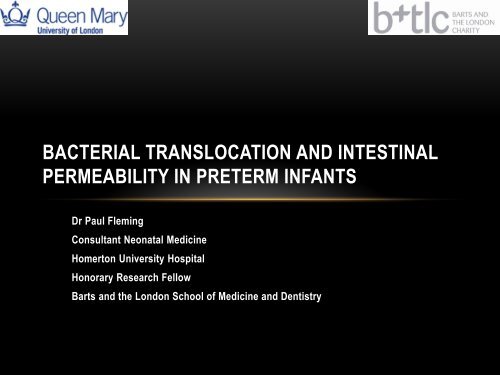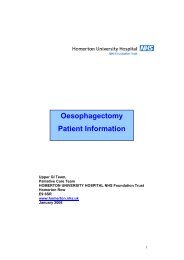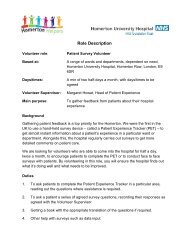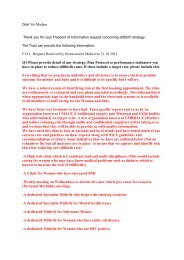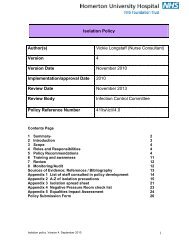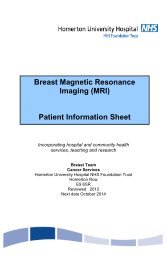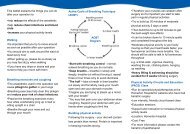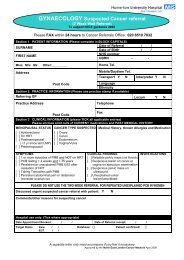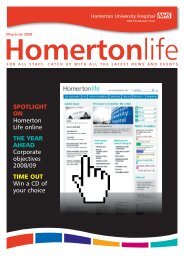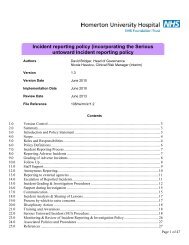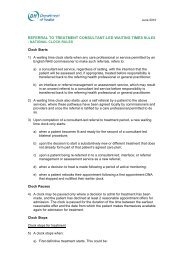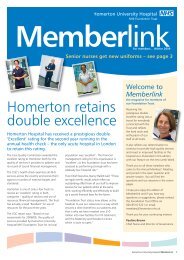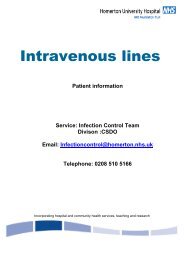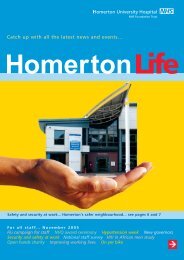Intestinal Permeability and Bacterial Translocation in Preterm Infants
Intestinal Permeability and Bacterial Translocation in Preterm Infants
Intestinal Permeability and Bacterial Translocation in Preterm Infants
You also want an ePaper? Increase the reach of your titles
YUMPU automatically turns print PDFs into web optimized ePapers that Google loves.
BACTERIAL TRANSLOCATION AND INTESTINAL<br />
PERMEABILITY IN PRETERM INFANTS<br />
Dr Paul Flem<strong>in</strong>g<br />
Consultant Neonatal Medic<strong>in</strong>e<br />
Homerton University Hospital<br />
Honorary Research Fellow<br />
Barts <strong>and</strong> the London School of Medic<strong>in</strong>e <strong>and</strong> Dentistry
MICROBIOME<br />
90% of cells <strong>in</strong> the human body are bacterial, fungal, or<br />
otherwise non-human<br />
Turnbaugh PJ, et al. The human microbiome project. Nature.<br />
2007;449:804-10.
GUT FLORA & VERY LOW BIRTHWEIGHT INFANTS<br />
• Gastro<strong>in</strong>test<strong>in</strong>al flora <strong>in</strong> preterm <strong>in</strong>fants differs significantly when compared<br />
to term counterparts<br />
Björkström MV, Hall L, Söderlund S, et al. <strong>Intest<strong>in</strong>al</strong> flora <strong>in</strong> very-low birth<br />
weight <strong>in</strong>fants. Acta Paediatr. 2009;98(11):1762–1767<br />
• Dysbiosis refers to a disturbance <strong>in</strong> the balance of organisms <strong>in</strong> the<br />
microbiota that favours the outgrowth of potentially pathogenic constituents<br />
Maynard CL, Elson CO, Hatton RD, Weaver CT. Reciprocal <strong>in</strong>teractions of the<br />
<strong>in</strong>test<strong>in</strong>al microbiota <strong>and</strong> immune system. Nature. 2012 Sep<br />
13;489(7415):231-41
DISEASES RESULTING FROM DYSBIOSIS<br />
Rates of death for <strong>in</strong>fants 24-31 weeks Gestation/1000 Live Born<br />
<strong>Infants</strong> at At that Gestation (95% CI)<br />
Time Epoch Respiratory Morbidity Infection NEC<br />
1988-1994 127 (115-139) 13.52 (9.62-17.43) 7.35 (4.47-10.23)<br />
1995-2001 104 (91.8-116) 10.65 (6.84-14.46) 11.36(7.43-15.29)<br />
2001-2008 65.7 (55.99-75.41) 13.44 (9.04-17.87) 15.3 (10.61-19.97)<br />
Berr<strong>in</strong>gton JE, Hearn RI, Bythell M, Wright C, Embleton ND. Deaths <strong>in</strong><br />
preterm <strong>in</strong>fants: chang<strong>in</strong>g pathology over 2 decades. J Pediatr. 2012<br />
Jan;160(1):49-53.e1. Epub 2011 Aug 24.
DISEASES RESULTING FROM DYSBIOSIS<br />
Rates of death for <strong>in</strong>fants 24-31 weeks Gestation/1000 Live Born<br />
<strong>Infants</strong> at At that Gestation (95% CI)<br />
Time Epoch Respiratory Morbidity Infection NEC<br />
1988-1994 127 (115-139) 13.52 (9.62-17.43) 7.35 (4.47-10.23)<br />
1995-2001 104 (91.8-116) 10.65 (6.84-14.46) 11.36(7.43-15.29)<br />
2001-2008 65.7 (55.99-75.41) 13.44 (9.04-17.87) 15.3 (10.61-19.97)<br />
Berr<strong>in</strong>gton JE, Hearn RI, Bythell M, Wright C, Embleton ND. Deaths <strong>in</strong><br />
preterm <strong>in</strong>fants: chang<strong>in</strong>g pathology over 2 decades. J Pediatr. 2012<br />
Jan;160(1):49-53.e1. Epub 2011 Aug 24.
BACTERIAL TRANSLOCATION<br />
• <strong>Bacterial</strong> translocation (BT) def<strong>in</strong>ed as <strong>in</strong>vasion of <strong>in</strong>test<strong>in</strong>al bacteria through<br />
the mucosa <strong>in</strong>to normally sterile tissues<br />
Berg RD, Garl<strong>in</strong>gton AW. <strong>Translocation</strong> of certa<strong>in</strong> <strong>in</strong>digenous bacteria from the<br />
gastro<strong>in</strong>test<strong>in</strong>al tract to the mesenteric lymph nodes <strong>and</strong> other organs <strong>in</strong><br />
gnotobiotic mouse model. Infect Immun. 1979;23(2):403–411<br />
• Def<strong>in</strong>ition is extended to <strong>in</strong>clude bacterial tox<strong>in</strong>s or antigens which damage<br />
the <strong>in</strong>test<strong>in</strong>al epithelia <strong>and</strong> enter the circulation to result<strong>in</strong>g <strong>in</strong> a systemic<br />
<strong>in</strong>flammatory response<br />
Gatt M, Reddy BS, MacFie J. Review article: bacterial translocation <strong>in</strong> the<br />
critically ill -- evidence <strong>and</strong> methods of prevention. Aliment Pharmacol Ther.<br />
2007;25(7):741–757
BACTERIAL TRANSLOCATION IN VLBW INFANTS<br />
• VLBW <strong>in</strong>fants are particularly risk of BT because:<br />
• Dysbiosis<br />
• Immature <strong>in</strong>test<strong>in</strong>al epithelium<br />
• Immature immune system<br />
• BT frequently cited as the entry po<strong>in</strong>t lead<strong>in</strong>g to late onset sepsis (particularly<br />
gram negative septicaemias) <strong>and</strong> <strong>in</strong> the pathogenesis of necrotis<strong>in</strong>g<br />
enterocolitis (NEC)<br />
Hunter CJ, Upperman JS, Ford HR, et al. Underst<strong>and</strong><strong>in</strong>g the susceptibility of<br />
the premature <strong>in</strong>fant to necrotiz<strong>in</strong>g enterocolitis (NEC) Pediatr Res.<br />
2008;63(2):117–123<br />
Sharma R, Tepas JJ, 3rd, Hudak ML, et al. Neonatal gut barrier <strong>and</strong> multiple<br />
organ failure: role of endotox<strong>in</strong>s <strong>and</strong> pro<strong>in</strong>flammatory cytok<strong>in</strong>es <strong>in</strong> sepsis <strong>and</strong><br />
necrotiz<strong>in</strong>g enterocolitis. J Pediatr Surg. 2007;42(3):454–461
Coord<strong>in</strong>ated Neonatal Research at<br />
Homerton
<strong>Intest<strong>in</strong>al</strong><br />
Microbiota
<strong>Intest<strong>in</strong>al</strong><br />
Microbiota<br />
<strong>Intest<strong>in</strong>al</strong><br />
Epithelium
<strong>Intest<strong>in</strong>al</strong><br />
Microbiota<br />
Immaturity of<br />
GI immune<br />
System<br />
<strong>Intest<strong>in</strong>al</strong><br />
Epithelium
<strong>Intest<strong>in</strong>al</strong><br />
Microbiota<br />
Immaturity of<br />
GI immune<br />
System<br />
Abnormalities <strong>in</strong> GI<br />
Blood Flow<br />
<strong>Intest<strong>in</strong>al</strong><br />
Epithelium
What is the core component that makes<br />
this research work
<strong>Intest<strong>in</strong>al</strong><br />
Microbiota<br />
Immaturity of<br />
GI immune<br />
System<br />
MUCOSAL INJURY<br />
Abnormalities <strong>in</strong> GI<br />
Blood Flow<br />
<strong>Intest<strong>in</strong>al</strong><br />
Epithelium
Hypothesis<br />
That bacterial translocation of the <strong>in</strong>test<strong>in</strong>al<br />
wall may occur <strong>in</strong> asymptomatic preterm<br />
<strong>in</strong>fants <strong>and</strong> <strong>in</strong> some may represent an early<br />
stage of cl<strong>in</strong>ical sepsis <strong>and</strong> NEC
METHODS 1<br />
• <strong>Infants</strong>
METHODS 2<br />
• Prior to extraction, samples were pre-treated with lysozyme (50mg/ml) at<br />
37˚C for two hours <strong>and</strong> subsequently extracted us<strong>in</strong>g the Qiagen BioRobot<br />
EZ1 platform<br />
• 16S detection was performed us<strong>in</strong>g a probe-based real-time PCR assay<br />
previously described by Nadkarni et al 2002<br />
• The assay was optimised us<strong>in</strong>g the Biorad CFX thermo-cycler <strong>and</strong> follow<strong>in</strong>g<br />
MIQE guidel<strong>in</strong>e<br />
• Suitable controls were <strong>in</strong>cluded <strong>in</strong> each run<br />
• Cl<strong>in</strong>ical outcomes for all <strong>in</strong>fants were recorded
RESULTS 1: DEMOGRAPHICS<br />
• 61 <strong>in</strong>fants were recruited at Homerton University <strong>and</strong> the Royal London<br />
Hospitals between August 2010 <strong>and</strong> August 2012<br />
• Demographics:<br />
• 33 male <strong>and</strong> 28 female<br />
• Mean (SD) birth weight 913g (213)<br />
• Median (range) gestation 26 weeks (23-30)<br />
• 8 <strong>in</strong>fants (13%) developed NEC (≥Bells Stage II)<br />
• Mean birth weight was 775G (108)<br />
• Median gestation 27 weeks (25-28)<br />
• Median age at onset of 26 days (range 19-72)
RESULTS 2: SAMPLES<br />
• 213 samples were processed <strong>and</strong> 11 (5%) were positive<br />
11 positive samples<br />
5 positives from 5 babies<br />
who did not develop NEC<br />
6 positives from 3 babies<br />
who developed NEC
RESULTS 3: SEPSIS<br />
• 5 positive PCRs from 5 separate <strong>in</strong>fants<br />
• 3 of these babies had features of systemic sepsis with<strong>in</strong> 48 hours of<br />
sampl<strong>in</strong>g<br />
• 1 Klebsiella sepsis<br />
• 1 CoNS sepsis<br />
• 1 Cellulitis
REULTS 4: NECROTISING ENTEROCOLITIS<br />
• 3 <strong>in</strong>fants each had 2 positive PCRs<br />
• PCR was positive one week before <strong>and</strong> just prior to the onset of cl<strong>in</strong>ical NEC<br />
• Each of these <strong>in</strong>fants had severe NEC (Bells stage 3). One <strong>in</strong>fant died <strong>and</strong><br />
the other 2 required surgery <strong>and</strong> bowel resection<br />
• One positive PCR from an <strong>in</strong>fant who developed NEC resulted <strong>in</strong> a mixed<br />
sequence product <strong>and</strong> the rema<strong>in</strong><strong>in</strong>g samples did not sequence
PCR SAMPLES PRECEDING NEC<br />
Patient 1<br />
Patient 2<br />
Patient 3<br />
Patient 4<br />
Patient 5<br />
Patient 6<br />
Patient 7<br />
Positive<br />
Negative<br />
NEC<br />
Patient 8<br />
Week 1 Week 2 Week 3 Week 4 Week 5 Week 6 Week 7 Week 8
DISCUSSION<br />
• <strong>Bacterial</strong> translocation is frequently cited <strong>in</strong> the pathogenesis of late onset<br />
sepsis <strong>and</strong> NEC <strong>in</strong> preterm babies but human studies limited<br />
• Our data confirm that <strong>in</strong> some <strong>in</strong>fants who develop these conditions,<br />
bacterial translocation can be demonstrated <strong>in</strong> the absence of cl<strong>in</strong>ical signs<br />
<strong>and</strong> precede the onset of disease
Thank you<br />
Acknowledgements<br />
Parents <strong>and</strong> Patients<br />
Drs N Aladangady <strong>and</strong> A S<strong>in</strong>ha<br />
Cl<strong>in</strong>ical <strong>and</strong> Laboratory Staff at HUH <strong>and</strong> RLH<br />
Professors Kate Costeloe, Mike Millar, Ian S<strong>and</strong>erson <strong>and</strong> Tom MacDonald


